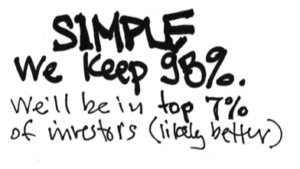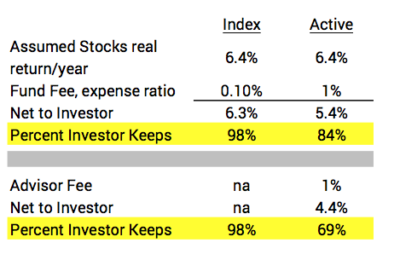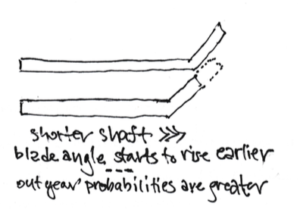We Nest Eggers keep 98% of what the market gives all investors.
Posted on March 23, 2018

It’s a key part of the Nest Egger Way: Nest Eggers invest to be at least in the top seven percent of all investors. We invest to simply and efficiently keep 98% of what the market in aggregate gives all investors. We don’t try to earn more than what the market gives (gross returns). We accept we will earn less: just a tad less. Yet we will be in the top ranks of all investors over time. This post answers the question, “Why will keeping a tad less than market returns place us in the top ranks of investors?”

What do we Nest Eggers do? We simply and efficiently keep our investing cost (the net cost we incur relative to market returns) predictably to no greater than 0.10% of our portfolio. That’s likely a different view of how to invest than most of us had when we were in our Save and Invest phase, but we now know Spend and Invest is different. The hard core among us now love predictability and ONLY invest in broad-based, index funds: we purge our actively managed funds. We also don’t pay high advisor fees: the funds we own and our annual process steps to maintain the health of our portfolio are so simple that we don’t have to incur those costs.
This tactic of keeping investing costs rock-bottom low is less than flashy, but it works. We’re being really simple and yet, in aggregate, we’re consistently beating 1,000s of professional fund managers. They’re paid a ton (through the expense ratio that investors pay) to pick winners, avoid losers, buy at the right time, and sell at the right time; you’d think it would be easy to beat the market and more than overcome the costs that investors are paying them to do so. Yet, each year Nest Eggers beat 60% of the pros; we’re in about the top 40% of all funds that investors own. A minority of the pros in any year will do better than we do (all at the expense of those pros that do worse): most of those that do better will be just a little bit better, but some will be much better; those few get boasting rights as how smart they were that year.
But we just repeat our performance of being in the top 40% year after year. As the years pass, our rank just keeps rising. The pros are just too erratic in their performance. Most all of the ones with boasting rights in one year fall deadly silent in other years. Over time, we leave all but a handful in the dust. When we look back at our results over the years we then own the boasting rights.
Here’s the killer evidence. I cite three studies in Nest Egg Care, but this is a fourth study. It’s a thorough 30-page report. Here’s my short summary.
• Over a one-year period, 60% of funds headed by an active mutual fund manager failed to outperform what the market gave all investors. (This report is using market returns as the benchmark for comparison. Our investing cost is so low that I assume this comparison applies to the net we keep.) This means we Nest Eggers outperform 60% of the time. (You can see in the study that in some prior one-year periods Nest Eggers outperformed 80%.)
• Over a five-year period, 85% of active fund managers failed to outperform. They are inconsistent. The ones that did well in a year or two don’t repeat. We Nest Eggers outperform 85% of the time. (We’re in the top 15%. I find it pretty amazing that we outperform that many in that short period of time.)
• Over a 15-year period, about 93% of active fund managers failed to outperform. We Nest Eggers outperform 93% of the time. We’re in the top 7%.
We’re actually better than this. This is comparing results of funds not investors. Investors who hold more than one actively managed fund (And they all own many more than just two or three.) won’t hit that 93% mark. They’ll be lower since not all the funds they own will be in the top 7%; the average of the funds they own will be less. And these data exclude the effect of added investment advisor fees that many retirees pay. That would make Nest Eggers’ rank even better.
=============================
It’s not easy for our brains to absorb and accept this evidence. It’s just not how we think about ourselves: we work hard; we are smart; we are above average. That’s why we have a nest egg to worry about. Investing to accept a shade less than what the market gives all investors (gross market returns) just doesn’t seem to fit who we are. Our brains and our ego tell us we can do better than that. (And, boy, does the financial industry live off this mental misfit with the facts.)
My friend, Dave, is an example, of someone who has not changed from the way he has invested for years. Dave invests in actively managed funds as he has his whole life; he also pays an advisor to look for openings and ways to beat the market. (I think Dave actually has some disdain for index funds.) The cold, hard evidence says that this approach is not the winning game tactic for his stage of life. I’ve not had success in convincing him to change what I now consider to be a very bad habit.
Why will Dave underperform? Dave and others like him are going to spend unnecessarily and on average only keep about 85% of the returns the market will give. Why? Because the greater fees of actively managed funds lower what the typical investor keeps by about one percentage point (See Chapter 6, Nest Egg Care for detail.) Since Dave employs an advisor at about another one percentage point, he most likely will keep only about 70% of what the market will give all investors over time. Those differences could add up to roughly $500,000 over the years. (See Chapter 6.) That’s a heck of a lot less for Dave to ENJOY or to have for his heirs.

Worse (and something few ever discuss), Dave’s changed the shape of his hockey stick – the curve of the year-by-year probability of depleting a portfolio. He’s shortened the shaft of a stick that he thinks is safe: it’s fewer years than he thinks to the first chance of depleting. The blade angle (the rising probability of depleting thereafter) starts its rise earlier. That earlier rise translates to a probability of depleting that’s maybe six times in out years than it would be if his investing costs were like mine. (See Chapter 6 again.)

Conclusion: We Nest Eggers are hard working, smart, and above average. We’re logical, efficient and effective. We are able to accept the evidence that tells us to invest to predictably keep 98% of what the market (stock and bond returns) gives all investors: this decision is central as to who we are. When we keep 98%, we will be in the very top ranks of investors over time.